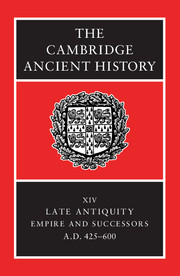Book contents
- Frontmatter
- PART I CHRONOLOGICAL OVERVIEW
- PART II GOVERNMENT AND INSTITUTIONS
- PART III EAST AND WEST: ECONOMY AND SOCIETY
- 12 Land, labour and settlement
- 13 Specialized production and exchange
- 14 The family in the late Roman world
- 15 Family and friendship in the west
- 16 State, lordship and community in the west (c. A.D. 400–600)
- 17 Armies and society in the later Roman world
- PART IV THE PROVINCES AND THE NON-ROMAN WORLD
- PART V RELIGION AND CULTURE
- Conclusion
- Chronological Table
- BIBLIOGRAPHY
- Index
- References
16 - State, lordship and community in the west (c. A.D. 400–600)
from PART III - EAST AND WEST: ECONOMY AND SOCIETY
Published online by Cambridge University Press: 28 March 2008
- Frontmatter
- PART I CHRONOLOGICAL OVERVIEW
- PART II GOVERNMENT AND INSTITUTIONS
- PART III EAST AND WEST: ECONOMY AND SOCIETY
- 12 Land, labour and settlement
- 13 Specialized production and exchange
- 14 The family in the late Roman world
- 15 Family and friendship in the west
- 16 State, lordship and community in the west (c. A.D. 400–600)
- 17 Armies and society in the later Roman world
- PART IV THE PROVINCES AND THE NON-ROMAN WORLD
- PART V RELIGION AND CULTURE
- Conclusion
- Chronological Table
- BIBLIOGRAPHY
- Index
- References
Summary
This chapter will examine some of the overlapping groups – communities – in which individuals acted for different purposes, and the transformation of these communities, in the period c. 400–600. It is focused on the west, because it was here that the greatest changes in our period took place, and where there was least continuity through imperial institutions such as the army and administration. The chapter draws on, and is intended to reflect, recent work on the social history of the early medieval period, and examines both horizontal ties, bonds between relatively equal peer groups, and vertical ties, such as those of patronage and support between lord and follower. It is divided into two parts. The first section focuses on the different sense of community operating at the level of the political centre: the Roman empire as a whole and the kingdoms which succeeded it. The spotlight is then transferred to more local communities. The two types of community are, of course, closely linked. An overall theme of the whole essay, indeed, is that socio-political transformations at the centre had profound effects upon the construction of local community, and vice versa.
THE COMMUNITY OF THE REALM
In c. 400, western Europe was dominated by the Roman empire. Britain south of Hadrian’s Wall, France, the Iberian peninsula, the Benelux countries, Italy and much of Germany and Austria were under its direct rule. Roman power also loomed over the empire’s neighbours. By c. 600, this European superstate had given way to a series of far from stable successor states: kingdoms built around Franks and Burgundians in France and Benelux, Visigoths and Sueves south of the Pyrenees, Ostrogoths and Lombards in Italy, Anglo-Saxons in southern and eastern Britain. The first half of this essay is concerned with the transformations in political economy which accompanied this fundamental revolution in European history
- Type
- Chapter
- Information
- The Cambridge Ancient History , pp. 437 - 468Publisher: Cambridge University PressPrint publication year: 2001
References
- 1
- Cited by

